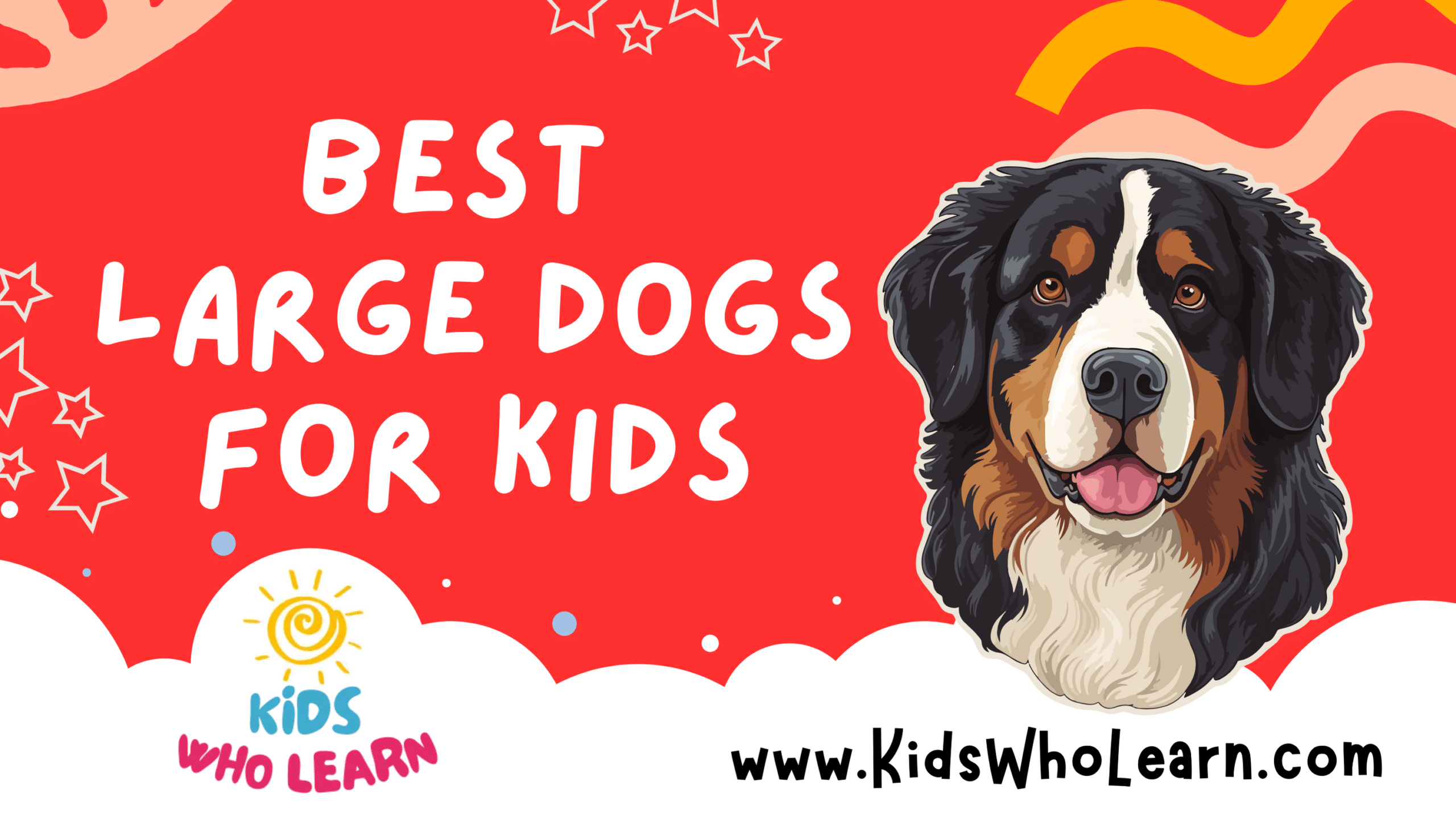Selecting a large dog as a family pet can be a wonderful decision for households with children. Large dog breeds often possess traits like patience, gentleness, and a protective nature, which can make them excellent companions for kids. While small dogs are often thought of as more manageable, larger breeds can offer a sense of security and are typically better suited to the rough-and-tumble play of energetic children. Not only do they tend to be more tolerant, but their sturdy size means they’re less likely to be injured by accidental falls or hugs that are a little too enthusiastic.
However, it’s important to understand that a large dog requires more space, exercise, and food, which are key considerations before welcoming one into your home. When choosing a breed, factors such as temperament, energy levels, and grooming needs should be matched with your family’s lifestyle. Breeds like the Labrador Retriever, Golden Retriever, and Bernese Mountain Dog are often recommended for families with kids due to their friendly nature and trainability.
Key Takeaways
- Large dogs can be great companions for kids, offering affection and a sense of security.
- Careful consideration is needed to choose the right breed and prepare for a large dog’s needs.
- Proper training and socialization are essential for a harmonious family and pet relationship.
Benefits of Large Dogs as Family Pets
Large dogs can offer families both a loving companion and a sense of security. These gentle giants form strong, faithful bonds with children and bring inherent traits that make them ideal family pets.
Natural Protectors
We often find that large breeds such as the German Shepherd and Boxer are naturally protective of their families. Their size alone can deter unwanted visitors, but it is their protective nature that truly makes them reliable guardians. For example, a Newfoundland is known not only for its impressive stature but also for being incredibly gentle and patient, making them great watchful companions for kids.
Bonds with Children
Large dogs, like the Labrador Retriever and the Golden Retriever, are often very affectionate and make excellent playmates for children. They tend to be loving, loyal, and patient, which are essential qualities for interacting with young family members. Labs and Goldens are especially known for their ability to form enduring affectionate bonds with all family members, thriving on companionship and activities.
Inherent Traits of Popular Breeds
The Bernese Mountain Dog exemplifies many inherent traits that make these large breeds well-suited as family dogs. They are typically affectionate, loyal, and possess a gentle demeanor. A well-socialized Bernese will often display a deep level of patience and loving behavior towards children, encapsulating the ideal qualities of a family companion. These breeds have a balanced disposition that can complement a family’s lifestyle, whether that’s involving active play or providing calm company.
Choosing the Right Large Dog Breed
When selecting a large dog breed for a family with kids, it’s essential to consider temperament, trainability, and physical needs to ensure a good fit for your household.
Temperament and Energy Levels
Large dogs can be a great fit for families due to their often calm and patient demeanor. However, it’s crucial to find a breed that matches your family’s activity level. Breeds like the Labrador Retriever or Golden Retriever are known for their fun-loving and friendly nature, making them ideal playmates for children. They generally possess a good balance between energy and calmness, and their patient attitude makes them suitable for families with kids.
- Calm and Patient: Newfoundland, Bernese Mountain Dog
- High Energy and Fun-Loving: Boxer, Standard Poodle
Trainability and Intelligence
We recognize that having a trainable and smart dog can greatly benefit a family environment. Breeds like the German Shepherd and Border Collie are not just intelligent, they are also highly trainable, with excellent problem-solving skills. An intelligent breed that is capable of learning commands can be a joy to teach and can integrate well into a family setting if trained properly.
- High Trainability: Labrador Retriever, Collie
- Intelligent Problem-Solvers: Poodle, German Shepherd
Physical Attributes and Grooming Needs
Our focus should also be on a breed’s physical attributes and grooming requirements. Some large dogs, like the Mastiff or Great Dane, can be quite imposing but are often gentle giants, and their short coats shed minimally, making grooming a breeze. Conversely, other breeds such as the Saint Bernard may require more frequent grooming due to their longer coats.
- Minimal Grooming: Mastiff, Great Dane
- Potential for Shedding: St. Bernard, Siberian Husky
Health Considerations and Lifespan
Considering the health and lifespan of large dog breeds is key for families looking for a long-term family companion. We should aim for breeds with fewer genetic health issues. The lifespan of larger dogs can be shorter than smaller breeds, but with proper care, breeds like the Labrador Retriever and Golden Retriever can live 10-12 years, offering a decade or more as a cherished family member.
- Longer Lifespan Breeds: Labrador Retriever, Golden Retriever
- Health Considerations: Hip dysplasia in German Shepherds, Heart conditions in Great Danes
It’s important for us to align our lifestyle and home environment with the needs of the large dog breed we choose to ensure a harmonious and joyful addition to our family.
Preparing Your Home for a Large Dog
Before welcoming a large dog into your home, it’s crucial to prepare your environment to meet their needs for space, exercise, and comfort while ensuring safety and establishing clear rules.
Space and Exercise
- Assessing Your Space: Large dogs require ample room to move around. Ensure you have a fenced yard or nearby park where they can exercise.
- Daily Exercise Commitments: We must be prepared to provide them with daily walks and outdoor activities, as adequate exercise is vital for their physical and mental well-being.
Safety and Comfort
- Creating a Safe Environment: Remove hazards like small objects that can be swallowed, and secure trash bins and toxic substances.
- Comfortable Resting Area: Provide a large, soft bed in a quiet corner. Dogs need a place to relax where they feel safe and comfortable.
Establishing Rules and Responsibilities
- House Rules: Decide on house rules before your dog arrives—where they’re allowed and not allowed, and how to handle begging.
- Shared Responsibilities: Assign family members specific tasks such as feeding, walking, and grooming, fostering a sense of responsibility.
Introducing Your Dog to Children
- Initial Introduction: Make first introductions in a controlled, calm environment, instructing children on gentle interactions with their new friend.
- Ongoing Supervision: Ensure that interactions between your dog and children of all ages are supervised to maintain a harmonious relationship.
Training Techniques for Large Dogs
When training large dogs, we must cater to their strength, intelligence, and sometimes independent nature. A well-planned training regimen that integrates obedience and positive reinforcement, while managing behavior and incorporating protection skills, will set them up for success.
Obedience Training Essentials
In obedience training, we focus first on basic commands such as sit, stay, come, heel, and down. These foundation commands are crucial for controlling a large breed in various situations. We should consistently practice these commands in short sessions to keep their attention and improve trainability.
- Sit: To teach this, we hold a treat above the dog’s nose and move our hand up, causing the dog’s head to follow and its bottom to lower. Once seated, we immediately reward them with the treat and praise.
- Stay: This command is built upon the sit command. After the dog sits, we use the verbal cue “stay” with an open-palm hand signal, step away, and then return quickly to reward calm behavior.
Exercise Regularity: Their substantial size demands regular physical activity to maintain their health and to channel their energy productively.
Positive Reinforcement Methods
Positive reinforcement involves rewarding desired behavior with treats, praise, or play to encourage that behavior again. We employ this method consistently to enhance our dogs’ problem-solving skills and trainability.
- Rewards: Treats are effective, but for large breeds that may gain weight easily, we can use praise or a toy as a reward.
- Consistency: We must reward the dog immediately after it performs the correct action for it to understand the connection between the behavior and the reward.
Addressing Behavioral Challenges
Large dogs can sometimes exhibit stubborn or boisterous behavior, which we can address through consistent and firm training techniques.
- Distraction Minimization: Training in a quiet environment initially can help minimize distractions.
- Calm and Assertive Leadership: We provide clear and firm instructions to assert leadership, especially with protective or alert breeds.
Specialized Training for Protection
When we train large dogs for protection, we must ensure they’re friendly and loving towards family while being alert and protective when needed. Specialized protection training should always be conducted by professionals.
- Protection Commands: Professional trainers can teach specific commands that cue the dog to be alert to potential threats or to stand down.
- Controlled Environment: Training in a controlled environment ensures the dog remains under command and doesn’t misconstrue normal interactions as threats.
By incorporating these training techniques, we effectively mold our large dogs into well-behaved, loving family members that can protect and serve when called upon.
Activities for Kids and Large Dogs
Integrating activities for children and large dogs fosters a strong bond, ensures both get adequate exercise, and teaches responsibility. We’ll explore suitable activities under four key categories.
Outdoor Fun and Games
Outdoor activities are essential for a dog’s exercise and playfulness. We recommend:
- Fetch: Engage in fetch using balls or frisbees to stimulate their running and retrieval instincts.
- Hiking: Take long walks or hikes in nature; it’s great for exploration and instilling a sense of adventure.
Create an obstacle course in your yard to combine fun with agility training. It’s a lively way to keep kids and dogs active and entertained.
Indoor Interactions
On rainy days or quiet evenings, gentle and calm indoor interactions are necessary:
- Tug-of-War: Use a sturdy rope and encourage gentle play.
- Hide and Seek: Hide treats or toys around the house to help their tracking skills.
Teaching commands through games can reinforce good behavior and patience while keeping interactions safe and controlled.
Learning and Growth Opportunities
Structured activities can teach kids and dogs alike about responsibility and social skills:
- Training Sessions: Work on new commands or tricks together.
- Feeding Time: Involve kids in feeding to teach them about dietary care and routine.
By turning training into a bonding experience, both kids and dogs learn cooperation and respect for one another.
Community Involvement
Lastly, stepping out into the community can enrich social experiences:
- Dog Parks: Visit local dog parks for socialization with other dogs and owners.
- Volunteering: Participate in events that allow dogs, which can foster a sense of community involvement and develop social skills.
Supporting each other in these activities, we encourage empathy, nurture social interactions, and provide avenues for ample play and exercise.
Healthcare for Large Breeds
When it comes to large dog breeds, our approach to healthcare is paramount to ensure they live long, happy lives as part of our families. Proper healthcare involves regular medical oversight, tailored nutrition, vigilance towards common health issues, and managing their physical activity.
Regular Veterinary Checkups
Regular checkups are essential for maintaining the health of large breeds. We recommend:
- Routine Examinations: At least once a year, to monitor growth in puppies and overall health in adults.
- Vaccinations: Follow a schedule as advised by the vet to protect against various diseases.
- Preventative Medications: Regular treatments for parasites like fleas, ticks, and heartworm.
Diet and Nutrition
A balanced diet is the cornerstone of good health. For large breeds, this means:
- High-Quality Food: Brands that cater to the nutritional needs of large breeds, high in protein and nutrients.
- Portion Control: Feed appropriate quantities to prevent obesity, based on age, size, and energy levels.
Dealing with Common Ailments
Large breeds often face specific health challenges. We stay informed about:
- Joint Issues: Dysplasia and arthritis are common; supplements and medications can help manage these conditions.
- Bloat: A serious condition that requires immediate veterinary attention; we understand its symptoms and preventive strategies.
Exercise and Weight Management
An active lifestyle is vital for these dogs’ wellbeing. We ensure our large breeds get:
- Regular Exercise: Daily walks, runs, and outdoor activities to match their energy levels.
- Healthy Weight: Monitoring their weight closely to reduce the risk of health issues related to obesity.
Living with Large Dogs in the City
https://www.youtube.com/watch?v=7qo4M4J3GJc&embed=true
We understand the unique challenges and joys that come with raising large dogs in urban settings. Large breeds often adapt well to city living with the proper guidance and care.
Adjusting to Smaller Spaces
Our large canine friends, often known as gentle giants, require space, but we can make urban apartments work with training and routine. It’s our responsibility to:
- Maximize space: Utilize multi-functional furniture allowing more room for movement.
- Routine exercise: Ensure they receive daily outings to offset the limited indoor space.
Navigating Urban Environments
To thrive in the city, large dogs must be alert and well-behaved. Our approaches include:
- Leash training: Practice walking on a leash to establish control in busy streets.
- Noise adjustment: Gradually expose them to urban sounds to reduce anxiety.
Community Parks and Dog-Friendly Areas
Outdoor activities are essential for our dogs’ wellbeing. We seek out dog-friendly spaces where our large dogs, known for their friendliness, can roam and play:
- Local parks: Search for parks with sufficient space for dogs to exercise and explore.
- Doggy playdates: Arrange meetings with other dogs to enhance their social skills.
Socialization and Behavior in Crowds
Socialization is integral for a friendly breed’s development. Our techniques involve:
- Crowd exposure: Regularly walk dogs in populated areas to increase their comfort with crowds.
- Positive reinforcement: Reward calm and friendly behavior to reinforce good conduct.
Through these methods, we foster loyalty and ensure our large dogs are a sweet and friendly presence in the cityscape.
Final Considerations
Before we bring a large dog into our homes, it’s crucial to consider the responsibilities and changes that come with owning a family companion that’s not just affectionate but requires a long-term commitment. We need to plan for the impact on our family dynamics, manage a budget for their needs, and look forward to the enduring love and companionship these loyal pets provide.
Long-Term Commitment
When we adopt a large dog, we’re making a promise that spans many years. Large dogs typically live for 8-12 years, and during this time, they rely heavily on us for their care. We must be ready to show loyalty and patience, as these family dogs depend on our constant support through their lifetime.
Impact on Family Dynamics
Introducing a large, affectionate dog alters the synergy of our household. It’s essential to ensure all family members are prepared for the strong bonds that will form and the shared responsibility every person will have in caring for our new family companion. This addition should be a unifying decision, promoting teamwork and empathy within the family unit.
Budgeting for a Large Dog
Caring for a large dog requires a dedicated budget. Here’s a breakdown of the typical monthly expenses we should anticipate:
| Expense Category | Estimated Cost (USD) |
|---|---|
| Food | $40 – $80 |
| Veterinary Care | $30 – $50 |
| Grooming | $30 – $50 |
| Insurance | $20 – $40 |
| Miscellaneous | $10 – $30 |
We must also factor in initial costs such as bedding, a crate, and training, among other necessities. Being financially prepared helps ensure our dog’s needs are met without strain.
Enduring Love and Companionship
The love and companionship a large dog provides are enduring. Their loyalty and affection enhance our quality of life, and in return, they ask for our care and attention. These strong bonds require us to step up as responsible pet owners, enriching our lives and theirs in the process.
Conclusion
When choosing the right large dog for a family with children, we must weigh several factors carefully. Our selection process has prioritized breeds known for their gentle nature, patience, and ability to bond with younger family members.
Here’s a quick checklist to guide us:
- Temperament: The dog should be known for a calm and friendly demeanor.
- Energy Levels: Match the dog’s activity level with our family’s lifestyle.
- Size: Consider the space we have available and the size of the dog when fully grown.
- Maintenance: Be aware of grooming needs and the dog’s potential health issues.
- Training Requirements: Choose a breed that is receptive to training for a safe and harmonious household.
In no particular order, these breeds have consistently shown themselves to be excellent companions for children:
- Labrador Retriever
- Golden Retriever
- Boxer
- Standard Poodle
- Newfoundland
Let us remember, however, that individual temperament and behavior can vary within any breed. Therefore, we should also seek out a dog with a suitable personality and take the time to train and socialize them properly with our children. It is crucial to supervise interactions between any dog and young children to ensure the safety of all.
Our choice of a large dog companion for our kids should be a thoughtful and well-informed decision. By doing so, we create a life-long bond that brings joy and companionship to our family.
Frequently Asked Questions
When selecting the ideal large dog breed for families with kids, we prioritize breeds known for their gentle nature and stable temperaments.
Which large dog breeds are known for being particularly gentle with children?
Newfoundlands, often referred to as “nanny dogs,” have a calm demeanor and a patient disposition. Similarly, Bernese Mountain Dogs are affectionate and gentle with kids.
What are the top recommended large dog breeds for families with kids?
We recommend Labrador Retrievers and Golden Retrievers as they are friendly, loyal, and particularly attuned to children. Another great option is the Collie, which is intelligent and known for being good with kids.
Which large breed dogs have the best temperament for a family-friendly environment?
Dogs such as the Irish Setter are known for their playful spirit and friendly attitude. Boxers can also be a good fit due to their protective nature and love for family play.
What are the most suitable gentle giant dog breeds for households with young children?
The Great Dane, despite its size, is a gentle giant perfect for families with children. Mastiffs are also known for their large size but docile temperament.
How do large dog breeds with short hair behave around kids?
Short-haired large breeds like the Vizsla and the Weimaraner are energetic and affectionate, often proving to be good companions for active children.
Can you suggest large dog breeds that are easy to manage alongside small dogs in a family setting?
Standard Poodles can live harmoniously with dogs of all sizes due to their intelligent and adaptable nature. Similarly, Boxers are playful yet have a patient side that makes them manageable with both large and small breeds.











